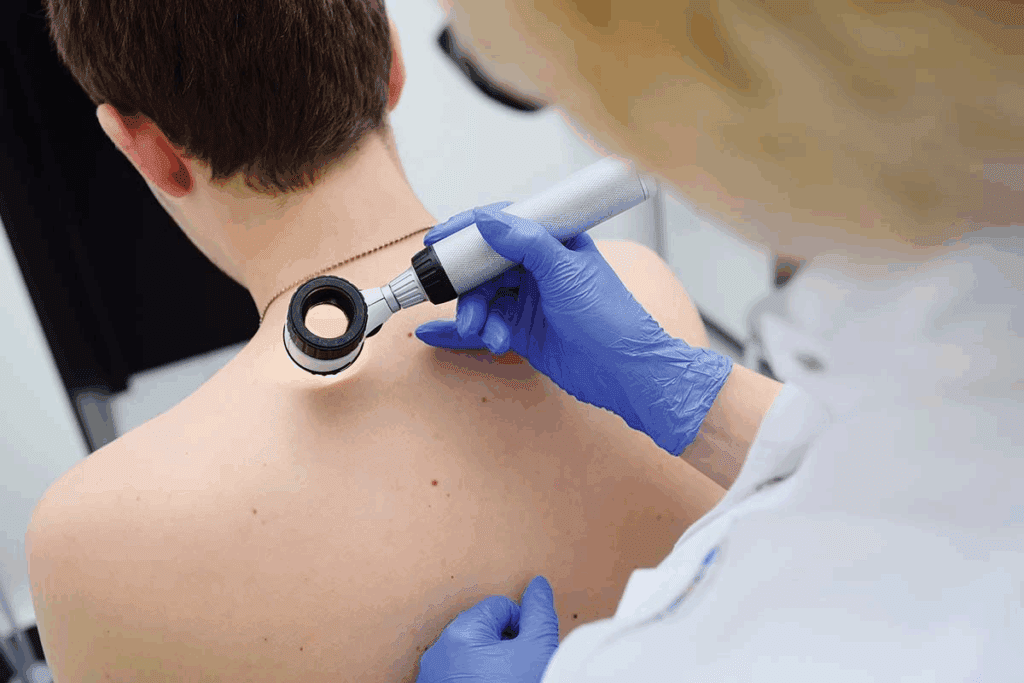Last Updated on November 27, 2025 by Ugurkan Demir

Skin cancer is a big health problem worldwide, hitting millions of people. Knowing the types of skin cancer and their signs is key for catching it early and treating it well.
We aim to give you a detailed guide to spot odd skin spots and know the signs of skin cancer. With about 1.8 million new cases every year, it’s vital to know the risks and protect your skin.
This guide will talk about the seven types of skin cancer, what they look like, and why catching them early is so important.

Skin cancer is a big worry in the U.S. It’s one of the most common cancers. More people are getting it, which worries doctors and everyone else.
Skin cancer is a big worry in the U.S. Every year, about 1.8 million people get squamous cell carcinoma (SCC). It’s very common, with over 9,500 new cases every day.
Key statistics include:
Finding skin cancer early is very important. If caught early, treatment works very well. For melanoma, the deadliest type, survival rates are over 99% if it’s caught early.
Early detection is key. It helps people live longer and avoid harsh treatments. This makes life better for those with skin cancer.
Being able to spot skin changes is vital. It helps catch skin cancer early. We suggest checking your skin often for new or changing spots.
Key visual cues to watch for include:
By watching for these signs, you can catch skin cancer early. This is a big help.

Knowing the common risk factors for skin cancer can help us avoid it. By understanding these risks, we can prevent and detect skin cancer early.
UV radiation from the sun or tanning beds is the main cause of skin cancer. Prolonged exposure to UV radiation harms skin cells, causing cancer. We must protect our skin with sunscreen, wear protective clothes, and stay in the shade when it’s sunny.
UV radiation is the main cause, but genetics and environment also matter. People with a family history of skin cancer or certain conditions are at higher risk. Environmental factors like chemicals and radiation also increase the risk.
Some groups face a higher risk, like those with fair skin or a history of skin cancer. We should watch for new or changing moles, sores, or unusual growths. Regular skin checks with a dermatologist are key for early detection.
By knowing these risk factors and taking steps to prevent them, we can lower our risk of skin cancer. Staying informed and proactive about our skin health is vital.
It’s important to know about basal cell carcinoma for early detection and treatment. It’s the most common skin cancer. Knowing its signs helps you tell it apart from other skin issues.
Basal cell carcinoma looks like a pearly or waxy bump on the skin. It might look like a harmless spot. It can also show up as a flat, flesh-colored, or brown scar-like mark. This type of skin cancer grows slowly and rarely spreads.
“Early detection is key to treating basal cell carcinoma effectively.” Dermatologists say it’s vital to spot its visual signs early.
Basal cell carcinoma often shows up on sun-exposed areas like the face, ears, neck, and scalp. This is why protecting your skin from the sun is so important.
Photos are key in diagnosing basal cell carcinoma. Look for telangiectasias (dilated blood vessels) and a rolled edge. These signs are often seen in clear photos.
“The use of dermoscopy has significantly improved the accuracy of basal cell carcinoma diagnosis by allowing for a more detailed examination of skin lesions.”
Understanding basal cell carcinoma’s look, growth, and where it shows up helps you spot it. This way, you can get medical help when needed.
Knowing how to spot squamous cell carcinoma (SCC) early is key. SCC starts in the squamous cells, which cover the skin’s outer layer. It’s a type of skin cancer.
SCC can look like a red, scaly patch or an open sore. It might be tender and bleed easily. Spotting SCC early is very important.
SCC can look like a wart or a sore that won’t heal. Knowing these signs, on sun-damaged skin, is vital.
SCC can grow and change shape as it gets worse. It might become thicker and scaly, bleeding or oozing. If it spreads, finding it early is even more critical.
Keep an eye on any skin changes. If you see something odd, see a dermatologist right away.
SCC often shows up on sun-exposed skin like the face, ears, and neck. It can also appear on the hands and arms.
| Location | Common Appearance |
| Face, ears, neck | Red, scaly patches or open sores |
| Hands, arms | Thick, scaly growths or wart-like lesions |
| Other areas (legs, trunk) | Variable; may resemble ulcers or nodules |
Knowing SCC’s look and where it shows up helps protect your skin. Regular skin checks and quick medical help are key to managing SCC.
Melanoma is the deadliest skin cancer, making early detection key. It grows from melanocytes, the cells that color our skin. Its fast growth and ability to spread make catching it early vital.
The ABCDE method helps spot melanoma. It looks for Asymmetry, Border irregularity, Color variation, Diameter over 6mm, and Evolving changes. This tool helps people check their skin and get help when needed.
Asymmetry means a mole isn’t even. Border irregularity shows a mole with odd edges. Color variation means a mole has different colors. Diameter is a problem if it’s over 6mm. Evolving means the mole is changing.
Melanoma comes in types like nodular melanoma and superficial spreading melanoma. Nodular melanoma grows fast and looks like a bump. Superficial spreading grows on the skin’s surface and is easier to spot early.
Melanoma can happen on any skin, looking different on each. On lighter skin, it’s a dark mole. On darker skin, it’s a color change or new growth. Knowing these helps catch it early, no matter your skin type.
Being careful about new or changing skin spots is important. The ABCDE method helps find melanoma early, improving treatment chances.
Merkel cell carcinoma and dermatofibrosarcoma protuberans are rare skin cancers. They grow fast and need quick action. These cancers are not as common as melanoma or basal cell carcinoma but are very dangerous.
Merkel cell carcinoma starts in Merkel cells in the skin’s top layer. It grows quickly and can spread. Early detection is key for treatment.
This cancer looks like a firm, painless bump on sun-exposed areas. It can be red, purple, or the same color as the skin. Because it looks like many things, a biopsy is needed to diagnose it.
Dermatofibrosarcoma protuberans (DFSP) grows slowly but can spread if not treated. It looks like a firm, painless bump on the skin, often on the trunk or limbs.
Finding DFSP early is hard because it grows slowly and looks harmless at first. But, if it keeps growing or changes, you should get it checked. DFSP can come back if not removed completely.
| Characteristics | Merkel Cell Carcinoma | Dermatofibrosarcoma Protuberans |
| Appearance | Firm, painless nodule or bump, often red, purple, or skin-colored | Firm, painless plaque or nodule, often on the trunk or limbs |
| Growth Rate | Rapid | Slow |
| Metastasis Potentia | High | Low, but locally invasive |
| Common Locations | Sun-exposed areas | Trunk, limbs |
Sebaceous carcinoma and Kaposi sarcoma are rare skin cancers. They can be tricky to diagnose because their symptoms are not clear. These cancers are not as common as others, but they need careful attention for the right diagnosis and treatment.
Sebaceous carcinoma is a rare, malignant tumor from the sebaceous glands. It usually shows up on the eyelids but can also appear on other facial and body areas. Because of its varied look, it’s often mistaken for something harmless like blepharitis or chalazion.
To spot sebaceous carcinoma, look for its unique features. Some signs include:
It’s important to catch it early. Sebaceous carcinoma can grow fast and spread. High index of suspicion is needed, mainly in those with certain risk factors.
Kaposi sarcoma is a rare, angiogenic neoplasm caused by human herpesvirus 8 (HHV-8) infection. It comes in different forms, like classic, endemic, iatrogenic, and epidemic (AIDS-related) Kaposi sarcoma. It can look like faint pink patches or deep purple plaques or nodules.
To spot Kaposi sarcoma, know its various looks and risk factors:
Early detection is vital. Kaposi sarcoma can grow and be dangerous, more so in those with weakened immune systems. Knowing its many forms helps in catching it early.
Skin cancer can show up in many parts of the body. It’s important to know the signs and symptoms in different spots. While it often appears in sun-exposed areas, it can also happen in less obvious places.
The face and scalp are common spots for skin cancer because they get a lot of sun. Look for new or changing growths, like unusual moles or lesions that bleed, ooze, or don’t heal in a few weeks. Pay extra attention to the nose, ears, and scalp, as these are high-risk areas.
It can be harder to spot skin cancer on arms and fingers because we don’t check them as often. Watch for suspicious spots that itch, hurt, or look different over time. Make sure to check your hands, including the backs, palms, and between fingers, as these are common places for skin lesions.
The trunk, including the stomach, back, and chest, is also a place where skin cancer can occur. Look for moles or lesions that are not symmetrical, have irregular edges, or are changing in color or size. It’s a good idea to use a mirror or ask someone to help check areas that are hard to see.
Don’t forget to check hidden or less exposed areas, like behind the ears, between toes, and the genital region. These spots can be prone to skin cancer and might not be noticed until it’s more serious. Regularly check these areas for any unusual changes, such as new growths or color changes.
By being careful and thorough in your self-exams, you can catch skin cancer early. Early detection is key to effective treatment and recovery.
Keeping your skin healthy is key to preventing and catching skin cancer early. Knowing the different types and what they look like helps us protect our skin. This knowledge lets us take action to keep our skin safe.
Finding skin cancer early makes treatment much more effective. It’s important to check your skin yourself and get professional checks too. This way, we can spot problems before they get worse. Everyone should watch for new growths or changes in moles on their skin.
Preventing skin cancer is also important. Using sunscreen, wearing protective clothing, and staying in the shade helps a lot. By preventing and catching cancer early, we can lower its risk.
We want you to take charge of your skin health. Keep an eye on your skin and get help if you see anything odd. Working together, we can fight skin cancer more effectively.
The most common types of skin cancer are basal cell carcinoma, squamous cell carcinoma, and melanoma. Basal cell carcinoma is the most common, making up about 80% of all cases.
Skin cancer on the face can look like a new or changing growth. It can also be a sore that doesn’t heal or a spot that is bleeding, itchy, or painful. Basal cell carcinoma often looks like a shiny bump or a pink patch. Squamous cell carcinoma can appear as a firm, red nodule.
Look for new or changing spots, sores that don’t heal, or areas that are bleeding, itchy, or painful on your arm or fingers. Check for unusual moles or growths. If you’re unsure, consult a doctor.
Melanoma on the scalp can be identified using the ABCDE method. Look for Asymmetry, Border irregularity, Color variation, Diameter greater than 6mm, and Evolving size, shape, or color. Be cautious of any new or changing moles on the scalp.
Yes, skin cancer can appear in hidden areas like behind the ears, between the toes, or in the genital region. Regularly check these areas for new or changing growths, sores that don’t heal, or unusual spots. If you’re concerned, consult a doctor.
Merkel cell carcinoma often appears as a firm, painless nodule or bump on the skin. It usually shows up on sun-exposed areas like the face, neck, or arms. It can be pink, red, or purple in color.
Sebaceous carcinoma can be hard to diagnose. It often appears as a painless nodule or lump on the eyelid or other areas of the face. It can be mistaken for a chalazion or other benign conditions. So, it’s essential to consult a doctor if you’re unsure.
The main risk factors for skin cancer include exposure to UV radiation and fair skin. History of sunburns, family history of skin cancer, and certain genetic conditions also increase the risk. Other factors like age, weakened immune system, and exposure to certain chemicals can also contribute.
To prevent skin cancer, protect your skin from the sun. Use sunscreen, wear protective clothing, and seek shade. Avoid tanning beds. Be mindful of reflective surfaces like water and sand that can increase UV exposure.
National Center for Biotechnology Information. (2025). 7 Types of Skin Cancer Photos Signs. Retrieved from https://www.ncbi.nlm.nih.gov/books/NBK441949/
Subscribe to our e-newsletter to stay informed about the latest innovations in the world of health and exclusive offers!